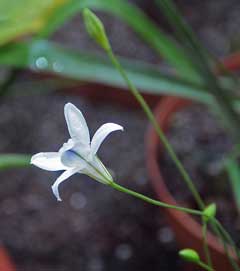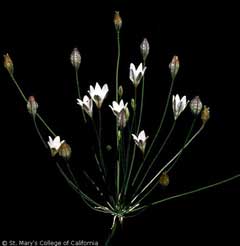 |
|
commons.wikimedia.org/wiki/User:Amada44 |
 |
| Brother Alfred Brousseau @ USDA-NRCS PLANTS Database |
Translate this page:
Summary
Physical Characteristics

 Triteleia peduncularis is a BULB growing to 0.3 m (1ft) by 0.1 m (0ft 4in).
Triteleia peduncularis is a BULB growing to 0.3 m (1ft) by 0.1 m (0ft 4in).
See above for USDA hardiness. It is hardy to UK zone 6 and is not frost tender. It is in flower from June to July. The species is hermaphrodite (has both male and female organs) and is pollinated by Insects.
Suitable for: light (sandy) and medium (loamy) soils and prefers well-drained soil. Suitable pH: mildly acid, neutral and basic (mildly alkaline) soils. It cannot grow in the shade. It prefers dry or moist soil.
UK Hardiness Map
US Hardiness Map
Synonyms
Brodiaea peduncularis (Lindl.) S. Watson
Plant Habitats
Cultivated Beds; East Wall. By. South Wall. By.
Edible Uses
Edible Parts: Root
Edible Uses:
Bulb - raw or cooked[105, 161]. Rich in starch, the bulb can be used like potatoes.
References More on Edible Uses
Medicinal Uses
Plants For A Future can not take any responsibility for any adverse effects from the use of plants. Always seek advice from a professional before using a plant medicinally.
None known
References More on Medicinal Uses
The Bookshop: Edible Plant Books
Our Latest books on Perennial Plants For Food Forests and Permaculture Gardens in paperback or digital formats.

Edible Tropical Plants
Food Forest Plants for Hotter Conditions: 250+ Plants For Tropical Food Forests & Permaculture Gardens.
More

Edible Temperate Plants
Plants for Your Food Forest: 500 Plants for Temperate Food Forests & Permaculture Gardens.
More

More Books
PFAF have eight books available in paperback and digital formats. Browse the shop for more information.
Shop Now
Other Uses
References More on Other Uses
Cultivation details
Requires a rich well-drained sandy loam[1]. Likes plenty of moisture whilst in growth followed by a warm dry period in late summer and autumn[200].
References Carbon Farming Information and Carbon Sequestration Information
Temperature Converter
Type a value in the Celsius field to convert the value to Fahrenheit:
Fahrenheit:
The PFAF Bookshop
Plants For A Future have a number of books available in paperback and digital form. Book titles include Edible Plants, Edible Perennials, Edible Trees,Edible Shrubs, Woodland Gardening, and Temperate Food Forest Plants. Our new book is Food Forest Plants For Hotter Conditions (Tropical and Sub-Tropical).
Shop Now
Plant Propagation
Seed - best sown as soon as it is ripe in a cold frame. Alternatively, the seed can be sown in spring in a cold frame. Germination usually takes place within 1 - 3 months at 15°c. Sow the seed thinly so that there is no need to prick them out and grow the seedlings on in the pot for their first year. Give an occasional liquid feed to ensure that they do not become mineral deficient. Seedlings are prone to damping off so be careful not to overwater them and keep them well ventilated. When they become dormant, pot up the small bulbs placing about 3 in each pot. Grow them on in the greenhouse for another year or two until the bulbs are about 20mm in diameter and then plant them out into their permanent positions when they are dormant in the autumn. Division of flowering size bulbs in autumn. Dig up the clumps of bulbs, replanting the larger ones direct into their permanent positions. It is best to pot up the smaller ones and grow them on in a greenhouse for a year before planting them out when they are dormant in early autumn.
Other Names
If available other names are mentioned here
Native Range
NORTHERN AMERICA: United States (California (west))
Weed Potential
Right plant wrong place. We are currently updating this section.
Please note that a plant may be invasive in one area but may not in your area so it's worth checking.
Conservation Status
IUCN Red List of Threatened Plants Status :

Growth: S = slow M = medium F = fast. Soil: L = light (sandy) M = medium H = heavy (clay). pH: A = acid N = neutral B = basic (alkaline). Shade: F = full shade S = semi-shade N = no shade. Moisture: D = dry M = Moist We = wet Wa = water.
Now available:
Food Forest Plants for Mediterranean Conditions
350+ Perennial Plants For Mediterranean and Drier Food Forests and Permaculture Gardens.
[Paperback and eBook]
This is the third in Plants For A Future's series of plant guides for food forests tailored to
specific climate zones. Following volumes on temperate and tropical ecosystems, this book focuses
on species suited to Mediterranean conditions—regions with hot, dry summers and cool, wet winters,
often facing the added challenge of climate change.
Read More
Expert comment
Author
Lindl.
Botanical References
71200270
Links / References
For a list of references used on this page please go here
Readers comment
| Add a comment |
|
If you have important information about this plant that may help other users please add a comment or link below. Only comments or links that are felt to be directly relevant to a plant will be included. If you think a comment/link or information contained on this page is inaccurate or misleading we would welcome your feedback at [email protected]. If you have questions about a plant please use the Forum on this website as we do not have the resources to answer questions ourselves.
* Please note: the comments by website users are not necessarily those held by PFAF and may give misleading or inaccurate information.
To leave a comment please Register or login here All comments need to be approved so will not appear immediately.
|
Subject : Triteleia peduncularis
|
|
|
|